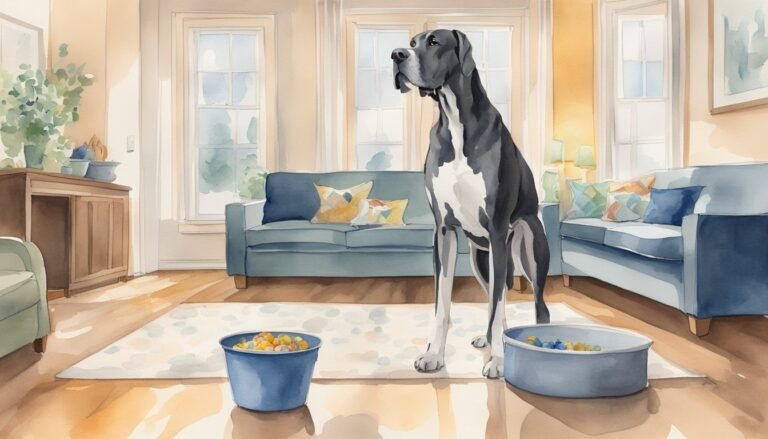9 Challenges of Owning a Great Dane: Navigating Life with a Gentle Giant

Great Danes are big dogs with even bigger hearts.
These gentle giants can make wonderful pets for the right owners.
But their size and unique needs come with special challenges.

Owning a Great Dane takes time, money, and hard work. You need to think about these things before you bring one home.
From health issues to training needs, Great Danes have specific care requirements.
Learning about these can help you decide if a Great Dane is right for you.
1) Space Requirements

Great Danes are huge dogs.
They need lots of room to move around comfortably.
Your home should have enough space for a large dog bed and room to stretch out.
A small apartment might not work well for a Great Dane.
These dogs do best in houses with big rooms and wide hallways.
They need space to turn around without bumping into things.
Your yard is important too.
Great Danes like to run and play outside.
A fenced yard gives them a safe place to exercise.
It doesn’t have to be huge, but it should be big enough for them to move freely.
Inside your home, you’ll need to make some changes.
Move breakable items to higher shelves.
Great Danes have long tails that can easily knock things over.
Consider the size of your car too.
Great Danes take up a lot of space in vehicles.
You might need a larger car or SUV for comfortable trips to the vet or park.
Remember, Great Danes grow quickly.
A puppy will soon become a very large adult.
Plan for the space requirements of a full-grown Great Dane, not just a cute puppy.
2) Dietary Needs

Great Danes have unique dietary needs due to their large size.
You’ll need to provide them with a balanced diet to support their growth and health.
Adult Great Danes typically need 6 to 10 cups of dry food per day.
It’s best to split this into two meals to prevent bloat.
Choose a high-quality dog food rich in animal protein.
Look for options that contain chicken, salmon, or beef as the main ingredients.
Your Great Dane’s diet should include about 23% protein and 12% fat.
This helps maintain their lean muscle mass and provides energy.
Be careful with homemade diets.
They can be tricky to balance, especially for growing puppies.
If you choose this route, consult with a veterinary nutritionist.
Avoid overfeeding your Great Dane.
Too much food can lead to rapid growth, which may cause joint problems later in life.
Always provide fresh water for your Great Dane.
Their large size means they need plenty of hydration throughout the day.
Remember to adjust your dog’s food intake based on their age, weight, and activity level.
Regular check-ups with your vet can help ensure your Great Dane’s diet meets their specific needs.
3) Training Challenges

Great Danes can be tricky to train due to their size and strength.
You need to start training early to prevent bad habits from forming.
These dogs grow fast, so it’s vital to teach them good manners while they’re still small.
Their large size can make it hard to control them if they’re not well-trained.
You might struggle to manage a full-grown Great Dane that hasn’t learned basic commands.
This is why consistent training is so important from the start.
Great Danes can be stubborn at times.
You’ll need patience and persistence to train them effectively.
They may not always listen, especially if they’re distracted or bored.
Socialization is another key challenge.
You need to expose your Great Dane to many different people, animals, and situations.
This helps prevent fear or aggression issues later on.
Leash training can be tough with Great Danes.
Their strength means they can easily pull you if not taught proper leash manners.
You’ll need to work extra hard on loose-leash walking skills.
House training can take longer with Great Danes compared to smaller breeds.
Their large size means bigger accidents, which can be frustrating to clean up.
Be prepared for a longer house training process.
Lastly, Great Danes need mental stimulation along with physical exercise.
Training sessions should be fun and engaging to keep their interest.
You may need to get creative with training methods to keep your Great Dane motivated.
4) Health Concerns

Great Danes face several health issues you need to be aware of.
One of the most serious is bloat, also known as gastric torsion.
This condition can be life-threatening and requires immediate veterinary care.
Hip dysplasia is another common problem in Great Danes.
This condition affects the hip joint and can cause pain and mobility issues.
Regular check-ups with your vet can help catch and manage this problem early.
Heart disease is also a concern for Great Danes.
Cardiomyopathy, which affects the heart muscle, is particularly common in this breed.
Watch for signs of fatigue or difficulty breathing.
Great Danes are prone to joint problems due to their large size and rapid growth.
Arthritis and other joint issues may develop as they age.
Proper nutrition and exercise can help maintain joint health.
Eye problems like cataracts and cherry eye can affect Great Danes.
Regular eye exams are important to catch these issues early.
The average lifespan of a Great Dane is 6 to 8 years.
This shorter lifespan is partly due to their size and health issues.
Regular vet check-ups and a healthy lifestyle can help maximize your dog’s years.
Be prepared for potential health costs.
Great Danes may require more frequent vet visits and specialized care due to their size and health risks.
Pet insurance might be a good option to consider.
5) Exercise Necessities

Great Danes need regular exercise to stay healthy and happy.
You might think these gentle giants are couch potatoes, but they actually require 30 to 60 minutes of daily exercise.
Your Great Dane’s exercise needs will change as they grow.
Puppies have more energy and need shorter, more frequent play sessions.
Adult Great Danes settle into a more moderate routine.
Walking is an excellent exercise for your Great Dane.
It helps keep their joints healthy and provides mental stimulation.
You can also try playing games, visiting dog parks, or swimming to mix things up.
Be careful not to overexert your Great Dane, especially in hot weather.
Their large size makes them prone to overheating.
Always provide plenty of water and take breaks as needed.
Remember that Great Danes grow quickly.
Too much exercise during their growth phase can harm their developing joints.
Consult your vet for guidance on the right amount of exercise for your dog’s age.
Mental exercise is just as important as physical activity.
Puzzle toys and training sessions can help keep your Great Dane’s mind sharp.
By providing the right amount and type of exercise, you’ll help your Great Dane maintain a healthy weight and avoid boredom-related behaviors.
It’s a key part of keeping your gentle giant happy and healthy.
6) Grooming Requirements
Great Danes have short, smooth coats that are relatively easy to maintain.
You’ll need to brush your Dane regularly to keep their coat healthy and reduce shedding.
A bristle brush or rubber grooming mitt works well for Great Danes.
These tools help remove loose hairs and dirt, leaving your dog’s coat shiny and clean.
Start at your Dane’s head and work your way down to the tail when brushing.
Make sure to brush in the direction of hair growth for best results.
Great Danes don’t need frequent baths unless they get dirty.
When you do bathe them, use a gentle dog shampoo to avoid skin irritation.
Pay attention to your Dane’s nails.
Trim them regularly to prevent discomfort and potential injuries.
If you’re not comfortable doing this yourself, consider professional grooming services.
Don’t forget about dental care.
Brush your Great Dane’s teeth regularly to maintain good oral health and prevent bad breath.
Check your Dane’s ears weekly for signs of infection or wax buildup.
Clean them gently with a damp cloth or dog-specific ear cleaner.
While Great Danes aren’t heavy shedders, they do shed seasonally.
During these times, you may need to brush your dog more frequently to manage loose hair.
7) Financial Costs

Owning a Great Dane can be expensive.
The initial cost to buy a Great Dane from a breeder ranges from $600 to $3,000.
If you choose to adopt, fees are usually lower, between $100 and $500.
Great Danes eat a lot due to their size.
You’ll spend more on food than you would for a smaller dog.
They also need large beds, crates, and toys, which cost more than those for average-sized dogs.
Vet bills can add up quickly for Great Danes.
They may need special tests for conditions like hip dysplasia and heart problems.
Regular check-ups and preventive care are crucial and can be costly.
Grooming costs are typically lower for Great Danes compared to long-haired breeds.
However, their size means you’ll use more shampoo and supplies when bathing them at home.
You might need to budget for training classes or a professional trainer.
Great Danes are gentle giants, but they need proper training to behave well in social situations.
Don’t forget about everyday items like collars, leashes, and treats.
These will need to be replaced more often due to the Great Dane’s size and strength.
Insurance for Great Danes can be pricey.
Many companies charge higher premiums for large breeds due to their potential health issues.
8) Longevity Expectations

Great Danes have a shorter lifespan compared to many other dog breeds.
You can expect your Great Dane to live between 8 to 10 years on average.
This shorter life expectancy can be hard for owners who form strong bonds with their gentle giants.
Some Great Danes may only live 6 or 7 years, while a few lucky ones might reach 12 years old.
Their size is a big factor in their shorter lifespan.
Large breeds often age faster and face more health issues than smaller dogs.
You’ll need to be ready for the emotional impact of having a pet with a shorter life expectancy.
It’s important to make the most of your time together and give your Great Dane the best care possible.
Regular vet check-ups can help catch health problems early.
Keeping your Great Dane at a healthy weight and giving them good nutrition may help them live longer.
Be aware that your Great Dane may face health issues like hip dysplasia and bloat as they age.
These conditions can affect their quality of life and may need special care or treatment.
Knowing about the typical lifespan of Great Danes can help you plan for their care throughout their life.
It also helps you make the most of your time with your loyal companion.
9) Emotional Bonds

Great Danes form strong emotional bonds with their owners.
Their loving nature means they’ll become deeply attached to you and your family.
These gentle giants often think they’re lap dogs.
They’ll try to cuddle up to you, even if they’re too big for your lap.
This can lead to funny and endearing moments.
You’ll find your Great Dane following you around the house.
They want to be near you all the time.
This closeness can be comforting but might also limit your personal space.
Great Danes are sensitive to their owners’ emotions.
They can pick up on your mood and may try to comfort you when you’re sad or stressed.
This empathy strengthens your bond.
The deep connection you’ll form with your Great Dane can make separations hard.
They may experience separation anxiety when left alone for long periods.
This can be challenging for both you and your dog.
Your Great Dane’s short lifespan can make the bond bittersweet.
These dogs typically live 7-10 years.
Knowing your time together is limited can be emotionally difficult.
The strong bond means your Great Dane will be very protective of you.
While this can make you feel safe, it may also lead to overprotective behavior if not managed properly.
Remember, the deep emotional connection you’ll share with your Great Dane is rewarding.
It requires commitment and can be intense, but many owners find it one of the most fulfilling aspects of having this breed.
Health Issues

Great Danes face several health challenges that owners need to be aware of.
Regular vet check-ups and understanding genetic risks are key to keeping these gentle giants healthy.
Common Genetic Disorders
Great Danes are prone to certain inherited health problems. Hip dysplasia is common, causing lameness and difficulty moving.
You may notice your dog struggling to stand or having a stiff gait.
Bloat, or gastric dilatation-volvulus, is a life-threatening condition for Great Danes.
It causes the stomach to twist, cutting off blood flow.
Watch for signs like a swollen belly or restlessness.
Heart issues, especially cardiomyopathy, can affect Great Danes.
This condition weakens the heart muscle.
Your dog might show symptoms like coughing or tiring easily.
Regular Veterinary Visits
Frequent vet check-ups are crucial for Great Danes.
Your vet can spot early signs of genetic disorders and other health issues.
They’ll check your dog’s heart, hips, and overall condition.
Vaccinations and parasite prevention are important parts of these visits.
Your vet will keep your Great Dane up-to-date on needed shots and treatments.
Dental care is often overlooked but vital.
Your vet can clean your dog’s teeth and check for any oral health problems.
This helps prevent more serious issues down the line.
Weight management is another key topic to discuss with your vet.
Great Danes need the right balance of diet and exercise to stay healthy and avoid joint problems.
Diet and Nutrition

Feeding a Great Dane properly is crucial for their health.
It’s important to know what and when to feed them.
Nutritional Needs
Great Danes need a diet high in protein to support their large size and muscle mass.
Look for dog food with at least 23% protein for adults and 25-30% for puppies.
Fats should make up 12-20% of their diet.
Choose food made for large breeds.
These have the right balance of calcium and phosphorus for healthy bones.
Avoid foods with too much calcium, as this can cause joint problems.
High-quality protein is key for muscle growth.
Good fats help with energy and coat health.
Carbs provide extra energy.
Feeding Schedule
Great Dane puppies need frequent meals to support their rapid growth.
Feed them 3-4 times a day until they’re 6 months old.
Then, switch to 2-3 meals a day.
Adult Great Danes do well with two meals a day.
This helps prevent bloat, a dangerous condition in large dogs.
Measure food carefully to avoid overfeeding.
Great Danes can gain weight easily, which puts stress on their joints.
Adjust amounts based on your dog’s age, weight, and activity level.
Always provide fresh water.
Space Requirements

Great Danes need a lot of room to move around comfortably.
Their size impacts both indoor living spaces and outdoor exercise areas.
Indoor Space Needs
You’ll need a roomy home for your Great Dane.
These giant dogs require significant space to stretch out and relax.
A small apartment might feel cramped for them.
Your furniture choices matter too.
Large, sturdy sofas and beds are best.
Great Danes love to lounge and may try to squeeze onto smaller furniture.
Hallways and doorways should be wide enough for easy passage.
Your Dane’s tail can easily knock items off tables, so clear lower surfaces.
Consider setting up a dedicated sleeping area with a giant-sized dog bed.
This gives your Dane a comfortable spot to rest without taking over your bed.
Outdoor Exercise Areas
Great Danes need daily exercise, but not as much as some smaller breeds.
A large, fenced yard is ideal for playtime and bathroom breaks.
If you don’t have a yard, you’ll need to find nearby parks or open spaces.
Look for areas with:
- Plenty of room to run
- Secure fencing
- Soft ground to protect joints
Remember, young Great Danes shouldn’t over-exercise as it can harm their growing bones.
Short, gentle play sessions are best for puppies.
Even adult Danes don’t need intense workouts.
A few 15-20 minute walks per day, plus some playtime, is usually enough to keep them healthy and happy.






